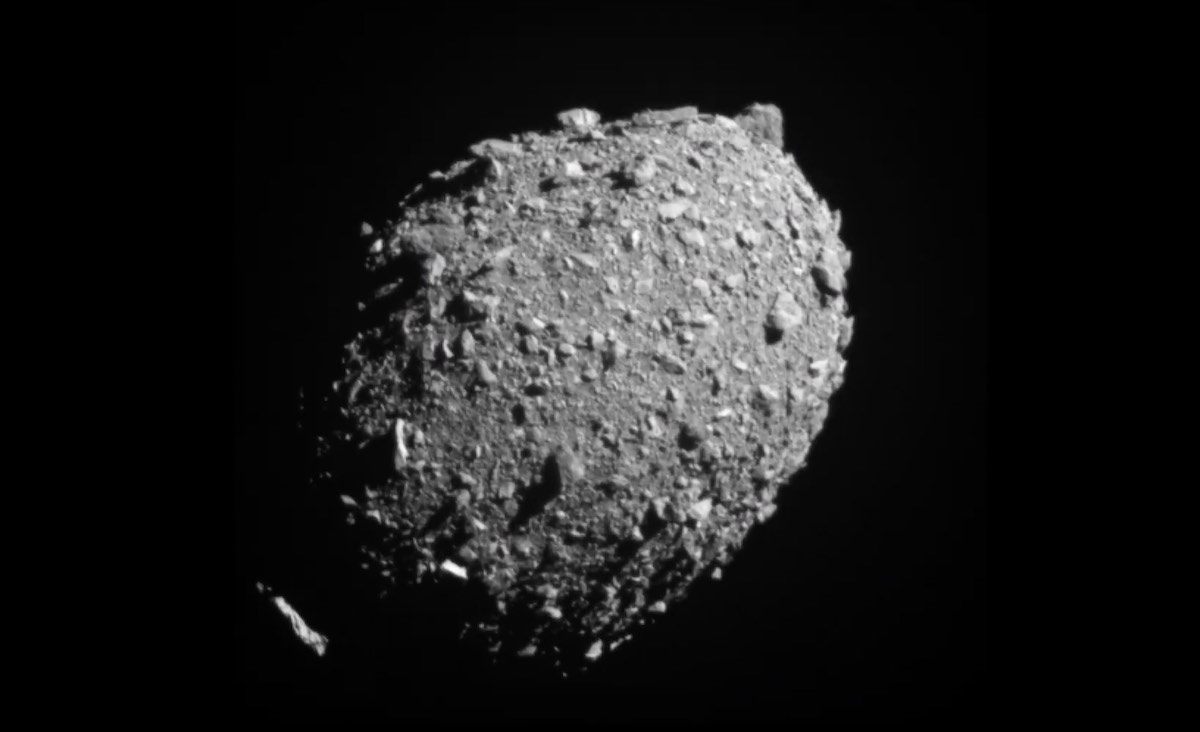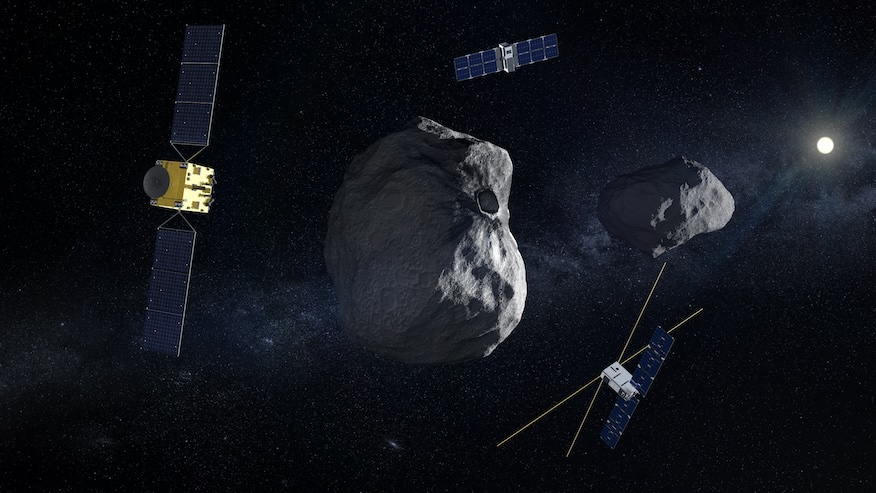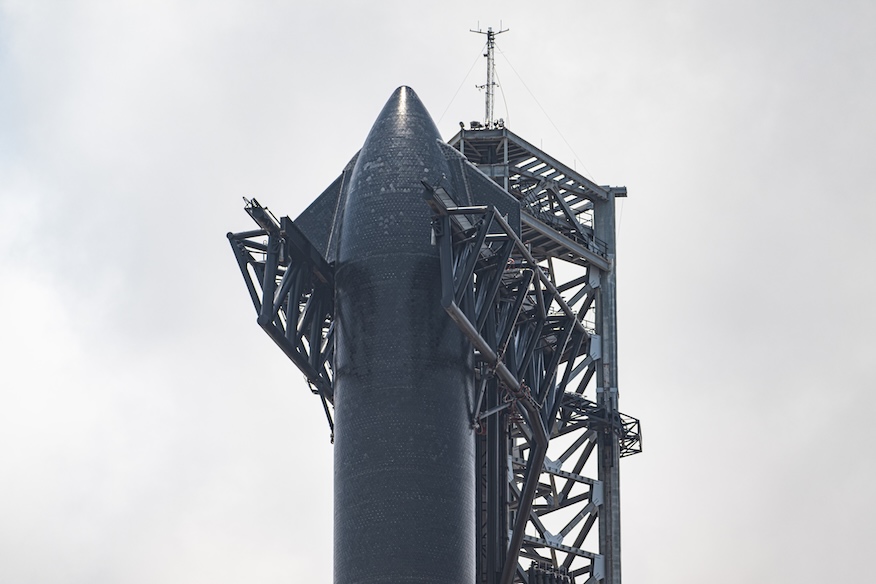
The European Space Agency is on the cusp of launching its first planetary defense mission, a complement to NASA’s 2022 Double Asteroid Redirection Test (DART) mission. The goal of these missions is to understand how Earth can be protected from a potentially destructive asteroid strike.
On Thursday, the Hera spacecraft, along with two CubeSats, are set to be encapsulated inside the fairings of a SpaceX Falcon 9 rocket ahead of a planned launch on Monday, Oct. 7. The moment will begin a roughly two-year journey out to the binary asteroid system of Didymos and its moon, Dimorphos.
At hand is a mission to study the impacts left by DART when it collided with Dimorphos in 2022, shortening is original 11-hour 55-minute orbit around Didymos by 32 minutes. The trio of spacecraft on the Hera mission will arrive at their target in 2026 to begin a six-month mission, making observations of the crater left by DART and collecting other data.
The mission that almost wasn’t
The concept of a twin satellite mission to an asteroid was originally pitched as an undertaking, called “Don Quijote,” and would’ve been entirely within ESA. Ian Carnelli, Hera’s project manager, said that in the early 2000s, the concept was a hard sell to political leaders needed to finance the undertaking.
“It was super difficult to sell to our decision makers. A mission that was not science, not purely technology, no human exploration, no robotic exploration. So, it was completely outside of any of the schemes that were in place,” Carnelli said. “Planetary defense didn’t exist. A planetary defense program didn’t exist in the agency and when you were explaining and trying to sell the mission to those deciding, most of the time they would laugh.”
In 2011, during a planetary defense conference in Bucharest, Romania, earnest discussions began between Carnelli and his scientists and NASA’s Applied Physics Lab (APL) about the idea of visiting a binary asteroid. From those conversations came the Asteroid Impact and Deflection Assessment (AIDA), which consisted of NASA’s DART and ESA’s Asteroid Impact Mission (AIM).
Under this mission design, AIM would arrive at Didymos and Dimorphos prior to DART and be there to witness the impact and the aftermath. Carnelli said he was optimistic about their prospects of getting financial backing from the European member states after NASA gave some funding to DART. However at a meeting of ESA member countries in 2016, European space ministers decided to put their money into other projects.

“Ministers and colleagues and everybody was absolutely convinced we were going to get the funding. And my hope started really to build. It was a lot of effort to get even to that point, to be even tabled for discussions for the funding. It was something completely new and very emotional,” Carnelli said. “And then in 24 hours, that dream just collapsed.”
He and his team tried numerous workarounds to reduce the cost of the mission or simplify it in ways that would make it more palatable for funding. After nearly giving up, Carnelli said the mission’s principal investigator, Dr. Patrick Michel, gave him some words of encouragement to keep him going.
“[He] said, ‘Look, we’re so close. We cannot give up now.’ And he gave me the little boost to make another try and so, I contacted the German delegates to the German Space Agency and said, ‘Look I think we could still do something,’” Carnelli recounted. “DART is moving forward. Let us continue a few more months to see if NASA actually approves DART.”
That pitch got the team about 4 million euros, which allowed them to press forward while “running on fumes.” But that was enough for them to get through the point of NASA approving DART and for them to get even more than they were asking for during the 2019 ministerial.
“In 2019, we were asking for 160 million euros to cover the industrial cost and we had more than 180. So, we even had more money than we asked, which was a big relief for us,” Carnelli said. “Made us more comfortable to work and place all the contracts. And I think the other positive side of this story is that by that time, all of the scientific payloads were very well defined. And so, when we signed the contract in 2019, everything was super clear.”
The challenge presented by the Covid-19 pandemic the following year provided a fresh wave of challenges, not only to the workforce, but also to their supply chain.
“Production had stopped and parts were basically, not stolen, but bought by many people, much faster and stocks were depleting. And stupid things like connectors or harnesses, sometimes even brackets, I mean, very simple stuff was just not there anymore,” Carnelli said. “So, that was wild. That was very wild.”
During a prelaunch press briefing, Carnelli said the team worked relentlessly go get the mission to the finish line.
“The integration team at OHB (Hera’s prime contractor) did an amazing job. The last units were delivered in April, May 2024 and they managed to literally assemble the satellite in three, four months and ship it… at the end of August,” he said. “It was really an amazing project and I can only be extremely proud of what we all achieved together.”
Flying companions
Riding alongside the primary Hera spacecraft are a pair of small spacecraft, called CubeSats: Juventas and Milani. The former is “devoted to the geophysical characterization of Dimorphous,” according to ESA, and the latter is “devoted to the visual inspection and dust detection of Didymos asteroid following DART impact.” The size of a CubeSat is measured in units abbreviated to “U” that are each 10 cm x 10 cm x 11.35 cm (3.94 in x 3.94 in x 4.47 in).
Carnelli said these two 6U CubeSats came into the picture in 2014, but were originally envisioned as 3U CubeSats. He said they need to be upscaled “to allow the CubeSats to be meaningful for what we were doing, to incorporate propulsion and have enough payload to embark in the additional complexity of having the CubeSats.”

The DART spacecraft was accompanied by the LICIACube (Light Italian CubeSat for Imaging of Asteroids), which was built by the Italian Space Agency. However, because Juventas and Milani were built with contracts dealing with ESA directly, it presented some new challenges.
“When we do contracts from ESA, then we are obliged to use European components from those countries participating, which means that we had to develop European radio, deep space radios. We had to develop specific propulsion systems in Europe,” Carnelli said. “We had to develop a lot more technology than at the time were not available yet in Europe.”
Rocket ride remix
Part of the saga of the Hera mission was finding a ride to space. When the mission was pitched during the 2016 ministerial their plan was to use a Soyuz rocket, launching from French Guiana. Carnelli said launching before DART, “we could have done it with a much lower energy.”
When they missed that opportunity, they had to pivot to at least a medium-lift vehicle, which led them to the Ariane 6 rocket. After some discussion about the need for true redundancy, especially given their uncompromising launch window of 20 days, Carnelli said they eventually were able to book SpaceX’s Falcon 9 as the backup.
When the Ariane 6 hit development delays, ESA decided in 2022 to move Hera to the Falcon 9. In order to get more performance out of the spacecraft, they will be using a fully expendable version of the Falcon 9 rocket.
“We’re going to use basically every single drop of propellant they have on board because we’re going to a very energetic orbit,” Carnelli said. “This will be the fastest ESA spacecraft ever launched and therefore, that’s actually why we need quite a bit of propellant onboard.”
However, following the delivery of the Crew-9 Dragon spacecraft to low Earth orbit on Sunday, Sept. 29., SpaceX said in a brief social media post that there was “an off-nominal deorbit burn” which caused the upper stage to “safely [land] in the ocean, but outside of the targeted area.”
The last time #HeraMission‘s radar-bearing Juventas CubeSat is seen with human eyes, being loaded aboard its Deep Space Deployer. The next time it is viewable will be when it is ejected into space around the Didymos binary asteroid, along with Hera’s 2nd CubeSat, Milani… pic.twitter.com/KS3ahPAtVp
— ESA’s Hera mission (@ESA_Hera) October 1, 2024
During an interview with Spaceflight Now on Tuesday, Oct. 2, Carnelli said they’ve been “informed about what is the most probable cause and we’re keeping our launch campaign nominal.” Liftoff is targeted for Monday, Oct. 7.
“We’re doing all we can. SpaceX is going to submit their report to the FAA, they said, by the end of the week and at that point, we’ll be in the hands of the FAA,” Carnelli said. “I hope really that we get a green light to move to the pad and launch on Monday.”
With NASA’s Europa Clipper mission also set to launch during a mid-October planetary launch window, Carnelli said he and his colleagues will be meeting Friday morning with Dr. Nicola Fox, the associate administrator for NASA’s Science Mission Directorate. They will be coordinating to ensure there is a healthy amount of distance between their two mission launches.
“Hera is ready for launch and I heard that Clipper is also ready for launch,” Carnelli said. “So, we just need to get all the pieces of the puzzle in the right place: weather, FAA and all the rest and I think we’re good to go.
“I’m confident we will both launch within our launch windows.”



